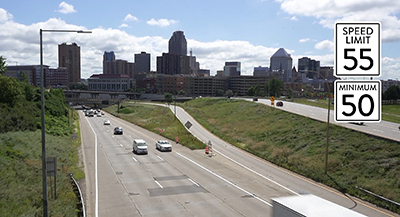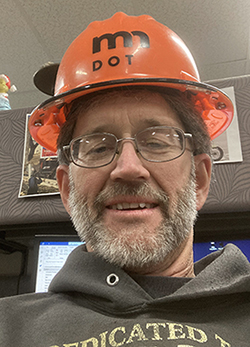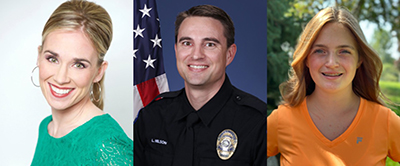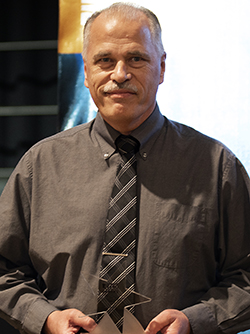 |
|

|
 |
TABLE of CONTENTS
 |
New Geometric Design Training Series offers lessons in roadway design |
By Doug Mack

A portion of the “Geometric Design - Design Speed and Target Speed” module. |
After two years in the making, MnDOT’s new Geometric Design Training Series is now available. This series, created by the Office of Project Management and Technical Support, consists of 29 modules that focus on the fundamentals of roadway design. The modules contain video segments, interactive illustrations, examples, exercises and final assessments.
The series replaces a curriculum that had been in use since the late 1990s, and had been created through a multistate pooled fund process, with MnDOT serving as the lead agency. Over the years, the content had become outdated, so in 2022 MnDOT coordinated a new multistate partnership agreement to update the training series to meet current design standards, best practices and technology. The other participating DOTs included Illinois, Missouri, North Dakota, Oregon and Texas.
Creating the new series was a major undertaking, with a budget of $2.8 million. The series covers a wide range of topics, from basic information like “Understanding 3 Basic Views: Plan, Profile, and Cross Section” to more technical topics like “Horizontal Alignment IV: Balancing Design Constraints.” While this training series is most applicable to designers who practice geometric design daily, there are also learning opportunities for anyone who wants a primer in roadway design.
For MnDOT employees, all 29 modules are available through the agency’s Learning Center by searching “geometric design.” For those looking for a brief review, standalone videos are available via the Geometric Design Training Series webpage on iHUB.
Because MnDOT considers this to be a valuable training resource, the agency has made it available to external partners, with the goal of benefiting the overall profession. MnDOT has contracted with the University of Minnesota to host the training series on their website for $50 per module.
“We are very excited at how this training series turned out and how well it has been received. In the first month on the University of Minnesota website, it has already attracted more than 1,000 external users,” said Gwen Mei, assistant state geometrics engineer, who was the project manager. “We have also received multiple compliments from external users thanking MnDOT for providing such valuable training resources.” |
| |
|

|
 |
TABLE of CONTENTS
 |
Electronic file cleanup competition offers chance to win Golden Hard Drive award |
By Megan Bauer, Office of Chief Counsel

Clean up electronic files to improve the agency’s function – and maybe win the Golden Hard Drive award. |
The MnDOT Information Governance Program within the Office of Chief Counsel is inviting all MnDOT employees to show off their new or existing electronic file organization systems, as part of a competition held across the agency.
The competition offers employees dedicated time to clean up electronic files, in advance of the new automatic deletion standards in Outlook that go into effect on Jan. 29, 2024. Winners will be selected from each storage location and posted on the Electronic File Cleanup SharePoint during the week of Jan. 15. The best submission overall will win the MnDOT Golden Hard Drive award.
To enter the competition, employees must submit a short narrative and basic documentation of their organization and cleanup system. Entries should be made using the dedicated Microsoft Form by Dec. 29, 2023. Organization systems from any MnDOT storage location are eligible, including network folders, ProjectWise, SharePoint and eDOCS.
Subject matter experts will judge submissions from each storage location based on the quality and scale of the organization system as well as the level of effort involved. Adrienne Hedlund, Business Integration Support, will judge network folder/shared drive organization systems.
“Success at MnDOT is not about how much data we have, but about how we use and maintain the data we need,” said Hedlund. Her Business Integration Support colleagues, Tony Cairns and Vanessa Bass, will judge SharePoint/Teams and eDOCS submissions.
All District Engineers and Office Directors are asked to schedule four hours for their business areas to work on electronic file cleanup through Friday, Dec. 29. On your timesheet, record cleanup activities as:
- Project ID – T0008102
- Activity Code/Source Type – 0023
Employees may spend this time moving emails from Outlook to new or existing electronic file organization systems. They should move emails that have both business value and delete dates on, before, or soon after Jan. 29, 2024. Any records should be moved to their designated storage location in the MnDOT records retention schedule.
“Making sure that you get rid of redundant, obsolete, and trivial information is good practice regardless of what platform or system you’re in,” said Jennifer W. Witt, MnDOT Information Governance Program supervisor. “It’s a good idea to see how things work for other people. If someone’s always coming to you to find stuff, that’s your sign that you’ve got a good organization system.”
Employees interested in submitting an entry should visit the MnDOT File Storage SharePoint for more information about file storage best practices. Contact Information Governance via email with any questions. |
| |
|

|
 |
TABLE of CONTENTS
 |
On the Job: Dave Malchow looks under the surface |

Dave Malchow |
By Doug Mack
All infrastructure projects start with a strong foundation – good soil, sound pavement. Dave Malchow, Transportation Specialist, in the Metro Materials Department, helps make it happen.
How long have you been at MnDOT and in what positions?
I started in the Fall of 2008 with the Foundations drillers who operate out of the Maplewood Lab facility. From there I moved over to the Metro Materials Soils Unit out of Water’s Edge. Whereas Foundations travels all over the state doing work in all districts, Metro Soils works primarily within a seven-county area.
What are your day-to-day tasks? Do they change throughout the year?
Our crew of five usually split up into two groups to go take pavement cores or take soil samples through auger borings. Cores show us pavement condition and pavement thickness. Soil sampling shows whether or not suitable grading material was used when the road was built, or if current soils are suitable to build on for possible new roadways. We’ll also do soil sampling for the Water Resources Dept. After having the samples of various soils graded at our lab at Maplewood Lab, the Water Resources Engineers determine if they can use that tested area for either filtration or infiltration basins. We could wish that our tasks would bring us indoors in the winter! We’re outside throughout the year, though, unless for safety reasons we need to stay off the highways during snow and ice operations.
How does your job fit into the broader work of MnDOT?
We are the eyes of the engineers who design our roadbeds and pavements. So, within the scope of MNDOT’s purpose our focus is pretty narrow, but still interesting. For instance, while on a jobsite we’ll look for and take note of various pavement distresses like cracking, sloughing or dips, and report those to the engineer for possible investigation. We’ll look at the level of ground water, or how saturated soil is at a given depth, and consider how that may contribute to pavement distress.
What’s the most challenging and rewarding parts of your job?
The most rewarding part of the job? That’s difficult to say, because there is nothing better than being in the middle of a field in summer, drilling for a new alignment. But since that doesn’t happen very often anymore, the next best part is discovering what combinations of sand, silt and clay lie beneath your feet. If getting your hands in the mud is fun for you, this job is it. Two aspects of the job tie for the most challenging part, and they are not being anxious about the highway traffic that is sometimes only four feet away from you as you work on a shoulder, and avoiding drilling into gas and electrical utilities.
How has your job changed since your first started?
When I first started our Metro unit didn’t know a thing about the features (redoximorphic) in soil that show the movement of the water table on a seasonal basis. About seven years ago, a water resource engineer taught us what to look for so that we can know how close to the surface water rises during the wet season, and at what depth water is present throughout most of the year. We also used to see more new alignments, or roadways, being built. Now we mostly only see highways being widened and turn lanes added, so that our work usually happens on the sides of highways.
As far as technology goes, we haven’t seen a real change in the last 15 years. We have always had some sort of handheld data collector to take a GPS position of our work and then to record our notes on the soil we bring up. There are some very sophisticated means of identifying sub-surface soils but, for us, the best way to know what is down there is to bring it up and see it. For that, we simply put the auger in the ground and “dead pull” it back out. It’s old-school, but accurate.
Is there anything about your job that might surprise other people (either inside or outside MnDOT)?
What may surprise people, and still takes me by surprise sometimes, is how destructive water is to our pavements. MNDOT has a research and testing facility (MnROAD) and a bituminous lab and a concrete lab, and has been finessing mix designs for decades.
What are your interests or hobbies outside your work with MnDOT?
I can take an interest in anything because I’m curious about everything. But I do love to be outside, doing anything, as long as it’s warm out. And since I’m from Arizona, warm is anything between 75 and 95. The next five months can be difficult, but nothing that five layers of clothing can’t get me through!
Do you or a co-worker have an interesting job to share with readers? Send us your ideas, and we’ll contact you for more information.
Recent employee profiles:
|
| |
|

|
 |
TABLE of CONTENTS
 |
Ceremony on Dec. 7 will announce MnDOT as a Yellow Ribbon Organization |
|
By Rich Kemp
MnDOT will become a Beyond the Yellow Ribbon Organization during a ceremony in the Capitol Rotunda Dec. 7 at noon. The event is open to all MnDOT employees.
A Yellow Ribbon Company unites all key areas within a company structure to create a network that connects and coordinates key areas throughout the company for the purpose of proactively supporting, recognizing and meeting the needs of service members, veterans and military families.
“I am excited for the Department to become a member of the BTYR Network,” said Jon Solberg, assistant division director in the Sustainability, Planning and Program Management Division. “The effort has taken several years, but it shows how committed the leaders of the agency are to our veteran and active service members. It is great to have a job in an organization where they understand, value and care about our servicemembers contributions.”
Thousands of Minnesotans have served and continue to serve our country. By developing a Yellow Ribbon Network within an organization, key areas unite to honor and embrace those affected by military service. The outward showing of support enables successful transition into the workplace for deployed service members, recognition and honor for all veterans and provides support systems for military-connected employees.
The 34th Infantry Division Band will perform during the ceremony along with remarks from Gov. Tim Walz, Commissioner Nancy Daubenberger and T.J. Melcher, District 2 Communication and Engagement and a Major in the Minnesota National Guard. A reception will follow the ceremony in the in L’ Etoile du Nord Vault in basement of Capitol.
|
| |
|

|
 |
TABLE of CONTENTS
 |
Toward Zero Deaths recognizes 16 traffic safety leaders |

2023 Minnesota TZD Award recipients included, from left, Holly Kostrzewski, Officer Luke Nelson and Makena Prevost. Submitted photos |
By J.P. Gillach
Minnesota’s Toward Zero Deaths program has honored sixteen individuals and three organizations with TZD Awards for accomplishments that improve safety and reduce the number of life-changing crashes, deaths and serious injuries on the state’s roads.
The awards were presented on Nov. 14 at the annual statewide TZD Conference, held this year at the Mayo Civic Center in Rochester. More than 800 traffic safety professionals registered to attend the conference in-person, or online.
Top honors
Holly Kostrzewski received the 2023 Kathy Swanson Outstanding Service Award, TZD’s top honor, for her years of exceptional leadership and accomplishments that have improved traffic safety in northeast Minnesota. In addition, four state elected officials received the TZD Distinguished Public Service award, and five individuals received TZD Star Awards in 2024.
TZD Awards and recipients
For details on each award, along with more information and photos of each award winner, visit the 2023 TZD Awards website. The 2023 TZD Awards winners are:
- TZD Kathy Swanson Outstanding Service Award: Holly Kostrzewski, National Highway Traffic Safety Administration safety specialist and former northeast Minnesota TZD regional coordinator.
- TZD Distinguished Public Leadership Award: State Senators Jim Carlson and D. Scott Dibble, and State Reps. Frank Hornstein and Lucy Rehm, for their work to update Minnesota’s traffic safety laws.
- TZD Media Award: Kyle Bradt, Olmsted County Sheriff’s Office media development specialist.
- TZD Traffic Safety Innovation Award: Renville County Public Health, Renville County Sheriff’s Office and the Minnesota State Patrol, for creating a program to improve access to car seats in greater Minnesota.
- TZD Judicial/Court System Award: Dakota County Attorney Kathy Keena.
- TZD Emerging Leader Award, primary and secondary school category: Makena Prevost, Orono, for successfully proposing and advocating that state law be changed to allow Minnesota driver’s license records to include information that lets crash responders know that a person in the vehicle has someone dependent on them who might need extra care.
-

Lars Impola, Metro District received the TZD Engineering Star Award. Photo by Rich Kemp |
TZD Emerging Leader Award, post-secondary school category: Darren Tanubrata, Aarushi Vyas, and Elizabeth Wang, interns from the Shreya R. Dixit Memorial Foundation for research leading to statewide implementation of the Impact Teen Driver program.
- Emergency Medical and Trauma Services TZD Star Award: Chris Ballard, former MDH trauma system coordinator, for his work to build Minnesota’s modern trauma system and creating an on-demand training for hospitals that increases the odds of survival for crash victims.
- TZD Child Passenger Safety Star Award: Aimee Eggen, Norman-Mahnomen Public Health child passenger safety technician.
- TZD Engineering Star Award: Lars Impola, acting traffic engineer, MnDOT Metro District.
- Enforcement TZD Star Award: Officer Luke Nelson, Eagan Police Department.
- Education TZD Star Award: K9 Deputy Luis Figueroa, Martin County Sheriff’s Office.
TZD Star Awards are presented annually to individuals and organizations in Minnesota that show excellence in TZD’s emphasis areas of enforcement, emergency medical and trauma services, education, engineering, child passenger safety and judicial/court systems. Award recipients have shown their leadership and creative capacities in efforts to improve traffic safety throughout the state and build partnerships.
The Minnesota TZD program is an interdisciplinary partnership led by the state departments of health, transportation and public safety. This collaboration began in 2003, and since that time, has worked to reduce roadway fatalities by 33%.
Learn more about TZD or how to get involved at the Minnesota TZD website. |
| |
|

|
 |
TABLE of CONTENTS
 |
Happy 140th birthday to the Stone Arch Bridge |

Completed in November 1883, this Minneapolis icon is a National Historic Engineering Landmark. It was originally built for rail traffic and carried both freight and passenger trains across the Mississippi River for decades before the line was officially abandoned in 1987. The Hennepin County Regional Railroad Authority purchased the bridge in 1989 and transferred ownership to MnDOT in 1992. MnDOT will begin repairs on the bridge in Spring 2024. To learn more, visit the Stone Arch Bridge project page. |
|
| |
|

|
 |
TABLE of CONTENTS
|
Name That Place Puzzler #14 |
By Doug Mack
Can you name the place pictured below? The ground-level photo is from Google and the satellite image is from the 511 website and app. Note that we’re looking for a specific location in this case (not just a highway or town). It’s the red dot east of the traffic camera on the map.
If you think you know the answer, email Newsline editor Doug Mack. The first three people to submit the correct answer will receive the fame and glory of having their names listed in the next issue of Newsline.
Answer to the last Puzzler: Veterans Memorial in St. Peter. The first people to get it right were Max McCabe (Metro), Eric Rustad (District 3) and Jeff Robb (District 7). Congrats to them and thanks to everyone who played!
Special thanks to Melissa Bartlett (Office of Maintenance), who suggested this location. If you know a place that would make a good Puzzler, please get in touch!
|
 |
|
|
|



